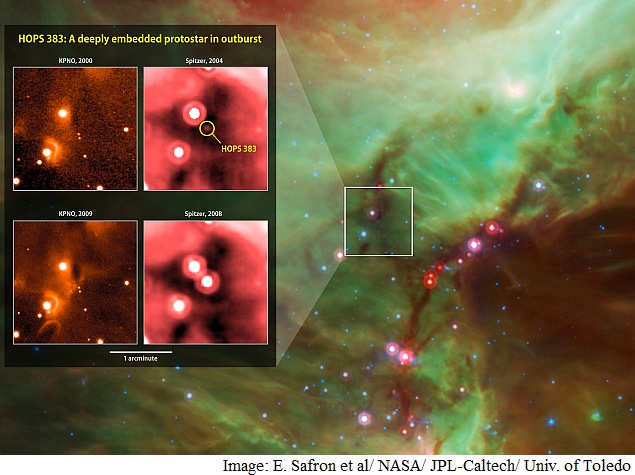- Home
- Science
- Science News
- Nasa Observes 'Growth Spurt' From Newborn Protostar
Nasa Observes 'Growth Spurt' From Newborn Protostar
By Indo Asian News Service | Updated: 24 March 2015 20:03 IST

Click Here to Add Gadgets360 As A Trusted Source

Advertisement
Using data from orbiting observatories and ground-based facilities, an international team of astronomers has discovered an outburst from a star thought to be in the earliest phase of its development.
The eruption, scientists say, reveals a sudden accumulation of gas and dust by an exceptionally young protostar known as HOPS 383. Stars form within collapsing fragments of cold gas clouds. As the cloud contracts under its own gravity, its central region becomes denser and hotter.
By the end of this process, the collapsing fragment has transformed into a hot central protostar surrounded by a dusty disk roughly equal in mass, embedded in a dense envelope of gas and dust.
Astronomers call this a "Class 0" protostar.
"HOPS 383 is the first outburst we have ever seen from a 'Class 0' object and it appears to be the youngest protostellar eruption ever recorded," said William Fischer, Nasa post-doctoral programme fellow at Nasa's Goddard Space Flight Center in Greenbelt, Maryland.
The "Class 0" phase is short-lived, lasting roughly 150,000 years, and is considered the earliest developmental stage for stars like the Sun.
A protostar has not yet developed the energy-generating capabilities of a Sun-like star, which fuses hydrogen into helium in its core. Instead, a protostar shines from the heat energy released by its contraction and by the accumulation of material from the disk of gas and dust surrounding it.
The disk may one day develop asteroids, comets and planets. The team continues to monitor HOPS 383 and has proposed new observations using Nasa's Stratospheric Observatory for Infrared Astronomy (SOFIA), the world's largest flying telescope.
The eruption, scientists say, reveals a sudden accumulation of gas and dust by an exceptionally young protostar known as HOPS 383. Stars form within collapsing fragments of cold gas clouds. As the cloud contracts under its own gravity, its central region becomes denser and hotter.
By the end of this process, the collapsing fragment has transformed into a hot central protostar surrounded by a dusty disk roughly equal in mass, embedded in a dense envelope of gas and dust.
Astronomers call this a "Class 0" protostar.
"HOPS 383 is the first outburst we have ever seen from a 'Class 0' object and it appears to be the youngest protostellar eruption ever recorded," said William Fischer, Nasa post-doctoral programme fellow at Nasa's Goddard Space Flight Center in Greenbelt, Maryland.
The "Class 0" phase is short-lived, lasting roughly 150,000 years, and is considered the earliest developmental stage for stars like the Sun.
A protostar has not yet developed the energy-generating capabilities of a Sun-like star, which fuses hydrogen into helium in its core. Instead, a protostar shines from the heat energy released by its contraction and by the accumulation of material from the disk of gas and dust surrounding it.
The disk may one day develop asteroids, comets and planets. The team continues to monitor HOPS 383 and has proposed new observations using Nasa's Stratospheric Observatory for Infrared Astronomy (SOFIA), the world's largest flying telescope.
Comments
Catch the latest from the Consumer Electronics Show on Gadgets 360, at our CES 2026 hub.
Related Stories
Popular on Gadgets
- Samsung Galaxy Unpacked 2025
- ChatGPT
- Redmi Note 14 Pro+
- iPhone 16
- Apple Vision Pro
- Oneplus 12
- OnePlus Nord CE 3 Lite 5G
- iPhone 13
- Xiaomi 14 Pro
- Oppo Find N3
- Tecno Spark Go (2023)
- Realme V30
- Best Phones Under 25000
- Samsung Galaxy S24 Series
- Cryptocurrency
- iQoo 12
- Samsung Galaxy S24 Ultra
- Giottus
- Samsung Galaxy Z Flip 5
- Apple 'Scary Fast'
- Housefull 5
- GoPro Hero 12 Black Review
- Invincible Season 2
- JioGlass
- HD Ready TV
- Laptop Under 50000
- Smartwatch Under 10000
- Latest Mobile Phones
- Compare Phones
Latest Gadgets
- Honor Win RT
- Honor Win
- Xiaomi 17 Ultra Leica Edition
- Xiaomi 17 Ultra
- Huawei Nova 15
- Huawei Nova 15 Pro
- Huawei Nova 15 Ultra
- OnePlus 15R
- Asus ProArt P16
- MacBook Pro 14-inch (M5, 2025)
- OPPO Pad Air 5
- Huawei MatePad 11.5 (2026)
- Xiaomi Watch 5
- Huawei Watch 10th Anniversary Edition
- Acerpure Nitro Z Series 100-inch QLED TV
- Samsung 43 Inch LED Ultra HD (4K) Smart TV (UA43UE81AFULXL)
- Asus ROG Ally
- Nintendo Switch Lite
- Haier 1.6 Ton 5 Star Inverter Split AC (HSU19G-MZAID5BN-INV)
- Haier 1.6 Ton 5 Star Inverter Split AC (HSU19G-MZAIM5BN-INV)
© Copyright Red Pixels Ventures Limited 2025. All rights reserved.

















